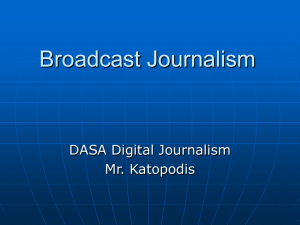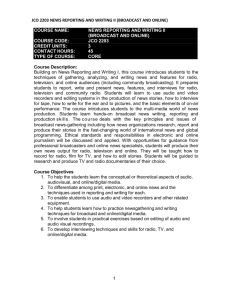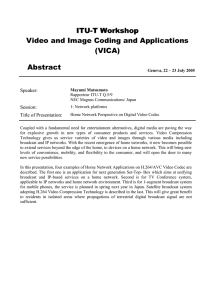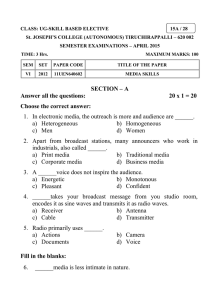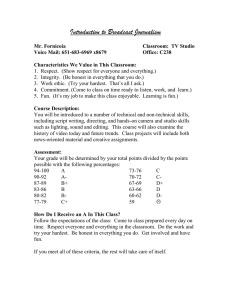Lesson Plan
advertisement
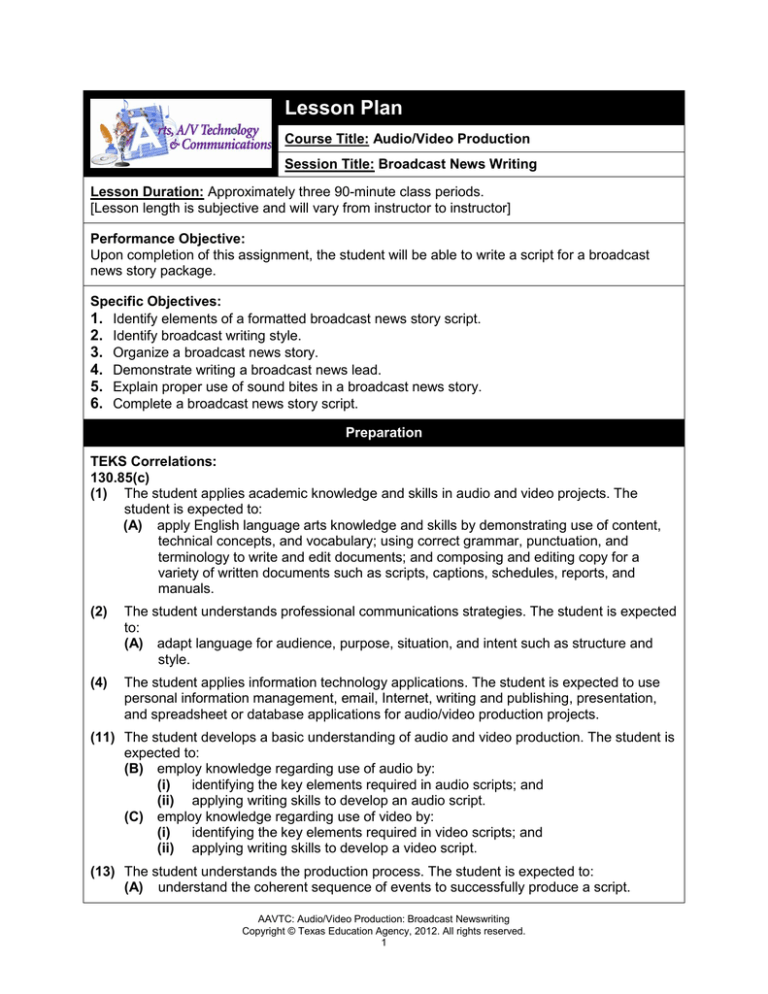
Lesson Plan Course Title: Audio/Video Production Session Title: Broadcast News Writing Lesson Duration: Approximately three 90-minute class periods. [Lesson length is subjective and will vary from instructor to instructor] Performance Objective: Upon completion of this assignment, the student will be able to write a script for a broadcast news story package. Specific Objectives: 1. Identify elements of a formatted broadcast news story script. 2. Identify broadcast writing style. 3. Organize a broadcast news story. 4. Demonstrate writing a broadcast news lead. 5. Explain proper use of sound bites in a broadcast news story. 6. Complete a broadcast news story script. Preparation TEKS Correlations: 130.85(c) (1) The student applies academic knowledge and skills in audio and video projects. The student is expected to: (A) apply English language arts knowledge and skills by demonstrating use of content, technical concepts, and vocabulary; using correct grammar, punctuation, and terminology to write and edit documents; and composing and editing copy for a variety of written documents such as scripts, captions, schedules, reports, and manuals. (2) The student understands professional communications strategies. The student is expected to: (A) adapt language for audience, purpose, situation, and intent such as structure and style. (4) The student applies information technology applications. The student is expected to use personal information management, email, Internet, writing and publishing, presentation, and spreadsheet or database applications for audio/video production projects. (11) The student develops a basic understanding of audio and video production. The student is expected to: (B) employ knowledge regarding use of audio by: (i) identifying the key elements required in audio scripts; and (ii) applying writing skills to develop an audio script. (C) employ knowledge regarding use of video by: (i) identifying the key elements required in video scripts; and (ii) applying writing skills to develop a video script. (13) The student understands the production process. The student is expected to: (A) understand the coherent sequence of events to successfully produce a script. AAVTC: Audio/Video Production: Broadcast Newswriting Copyright © Texas Education Agency, 2012. All rights reserved. 1 Interdisciplinary Correlations: English 110.31(b) (13) Writing/Writing Process. Students use elements of the writing process (planning, drafting, revising, editing, and publishing) to compose text. Students are expected to: (A) plan a first draft by selecting the correct genre for conveying the intended meaning to multiple audiences, determining appropriate topics through a range of strategies (e.g., discussion, background reading, personal interests, interviews), and developing a thesis or controlling idea; and (C) revise drafts to improve style, word choice, figurative language, sentence variety, and subtlety of meaning after rethinking how well questions of purpose, audience, and genre have been addressed. Instructor/Trainer References: • Ferguson, D. L., Patten, J., & Wilson, B. (2013). Journalism Today (6th ed.). New York, NY: McGraw-Hill/Glencoe. • Schaffer, J., McCutcheon, R., & Stoffer, K. T. (2008). Journalism matters. New York, NY: McGraw-Hill/Glencoe. • Tompkins, A. (2002). Write for the ear, shoot for the eye, aim for the heart: A guide for TV producers and reporters. Los Angeles, CA: Bonus Books. • Wulfemeyer, T. K. (2003). Beginning radio -TV newswriting. Ames, IA: Iowa State University. • http://www.poynter.org – online ethics • http://www.highschooljournalism.org • http://www.journalism.org/resources/tools/default.asp • http://bop.nppa.org/2010 - link to award winning broadcast news stories Instructional Aids: • Broadcast Newswriting slide presentation • News Package Assignment • News Script Rubric Materials Needed: • UIL Journalism Contest Practice Packets, http://www.uiltexas.org/ (order form for practice packets is under academics, journalism/ILPC http://www.uiltexas.org/journalism/ilpc) • Pen/pencil and paper • Newspaper articles Equipment Needed: • Computer with word processing software • Teleprompter and software (optional) • Computer with projector and appropriate software for lesson presentation Learner Previous lessons on journalism ethics, interview preparations, or lessons on producing a news package would be helpful. AAVTC: Audio/Video Production: Broadcast Newswriting Copyright © Texas Education Agency, 2012. All rights reserved. 2 Introduction MI Introduction (LSI Quadrant I): SAY: Broadcast news writing is conversational and to the point. At this point in your audio/video production studies, I’m sure you’ve heard that statement over and over again. Well, broadcast newswriting is not as easy as it seems. It is not a skill that you learn overnight; you must practice to develop this skill. Note: Ask students “What keeps you tuned in to anything you watch on television?” Wait for answers. SAY: In English class, we’re taught to find and use words much bigger than the basic. We’re taught to express our creativity in lengthy sentences that paint a picture. In broadcast news, the picture is there for you! Therefore, there’s no need to paint a picture…simply gain the interest of our audience, keep the story moving along, giving them a reason to care with an end result or guide to finding a solution. We present the facts and let our audience decide on their position. There’s a process to make sure that you or fellow crewmembers can easily understand how the story should come together for viewers to see. Today, we’ll look at how to format the script for such news stories, and how to provide a sense of purpose when we create them. Outline MI Outline (LSI Quadrant II): Instructor Notes: I. Determine elements of a formatted broadcast news story script. Script Preparation • Double-space copy. • Use upper and lower case. • Use columns – video left, audio right. • Use a separate sheet of paper for each news story. • Do not divide words at the end of a line. Start the word on the next line. • Do not continue a sentence on the next page. Begin the sentence on the next page. • Slug each story with story topic, reporter’s name, date, TRT (total running time). Slide presentation starts here. ASK: Why shouldn’t sentences break across pages? Makes it more difficult to sound conversational when you are reading and turning the page. Note: Double-spaced copy and use of upper/lower case varies from station to station. Develop your own style for your newsroom, and stick to it. Be sure to let students know that it varies from station to station, and in the real world, they must adapt to the particular style of their employer. AAVTC: Audio/Video Production: Broadcast Newswriting Copyright © Texas Education Agency, 2012. All rights reserved. 3 II. Identify broadcast writing style. Style • Use a natural, conversational style. • Keep the script conversational but simple. • Practice your script out loud as you write it. • Use action verbs, active voice. • Use words that are easy to understand. • Listener only has one chance to understand it; can’t reread it like in a newspaper. • Use short sentences. • Simple sentence structure, few commas. • Generally, one breath per sentence. • Use as few past tense stories as possible. • Time element, use yesterday, last night, or date without year. • Broadcast scripts are less wordy than print stories (if from a print journalism background). ASK: Why should you practice your script out loud as you write it? To make sure it sounds natural and conversational. III. Organize a broadcast news story. Organization • Every story needs a beginning (lead), middle (body), and end (closing/conclusion). • A preliminary script needs to be prepared so the camera operators know what needs to be recorded. • Words and pictures must go together. • Watch the video before writing the final story. • Let the picture describe the action. • Don’t tell the audience what they are seeing, explain the significance. • Tell the audience why you are including the shot, why the video is important. ASK: Why should you watch the video before you write the story? So the video and audio will match, go together and reinforce each other. IV. Demonstrate writing a broadcast news lead. Lead • Beginning and first, opening sentences of the story. • One or two sentences long. • Needs to grab the audiences’ attention, like a headline in a newspaper. • Begin with a descriptive phrase that will interest your viewer. • Lead with best video and best audio, need to grab and then hold attention. • Give the audience an idea of what the story is about, what happened. • The date and time don’t have to be in lead. • Include who, what, where, when, why, and how in the order the viewer will want to know about them. ASK: Why is it so important to hold the viewer’s attention? The viewer may stop watching your program; you want the viewer to watch the entire newscast. ASK: Why only one breath per sentence? It sounds more natural and conversational. AAVTC: Audio/Video Production: Broadcast Newswriting Copyright © Texas Education Agency, 2012. All rights reserved. 4 • Not all five W’s and H (who, what, where, when, why, and how) have to be in the broadcast lead. • The most important information usually goes first. • Avoid question leads. Body • Middle. • Must maintain viewer interest. • Create suspense. • Introduce new information throughout the story, reveal information as story develops. • Include details. • Avoid adjectives and adverbs. • Include verbs. • Use action verbs, active voice. • Use natural sound. • Body is a series of main points and supporting evidence. • Evidence is sound bites and statistics. • Use transitional sentences to tie segments together. • Let the video help your transitions. • Stories should flow. ASK: Why should question leads be avoided? The viewer could have a negative answer to the question and tune out. ASK: Why should you avoid adjectives and adverbs? They include or imply the reporter’s opinion. V. Explain proper use of sound bites in a broadcast news story. Sound Bites • Sound bites are usually less than 10 seconds long. • Explain who the interviewee is in your script. • Have their name and title appear in the graphic as well. • Introduce sound bites in a complete sentence. • Avoid “when asked.” • Incorporate some aspect of sound bite in introduction. • Do not repeat the same words the interviewee will say in the lead-in for the sound bite. Attributions • Tell the audience where information is from. • Report attributions at the beginning of the sentence. • Attributions and titles go before the person’s name. • Explain who the interviewee is in your script. • In a sound bite, have their name and title also appear in a graphic. • Also use CG over sound bite. • Use said or says; avoid words that editorialize. AAVTC: Audio/Video Production: Broadcast Newswriting Copyright © Texas Education Agency, 2012. All rights reserved. 5 VI. Complete a broadcast news story script. Ending • Last thought the viewer will have on story. • Make a connection to the lead. Can end by tying it back to the beginning. • Finish with supporting evidence or information on what may happen in the future or how to get more information. Introduce News Package Assignment Application MI Guided Practice (LSI Quadrant III): Use teacher resources available along with various journalism publications. As a class write leads and stories from information provided in teacher resources. MI Independent Practice (LSI Quadrant III): • Using UIL Journalism Contest Practice Packets (see Materials Needed), have students write a broadcast news story. Or • Using an article from a local newspaper, have students rewrite the story in a broadcast news story format. AAVTC: Audio/Video Production: Broadcast Newswriting Copyright © Texas Education Agency, 2012. All rights reserved. 6 Summary MI Review (LSI Quadrants I and IV): Q & A Session Q: Do you single or double-space a broadcast script? A: Double-space. Q: Is a broadcast script typed in upper, lower, or both upper and lower case? A: Both upper and lower case. Q: Should words and sentences break across pages? A: No. Q: What is included in a slug? A: Story topic, reporter’s name, date, and TRT. Q: Why should you use sentences and words that are easy to understand? A: Listener only has one chance to understand it. Q: How is a news story organized? A: Beginning, middle, and end. Q: Why should you watch the video before writing the final script? A: Words and pictures must go together. Q: What is a lead? A: Beginning, first, opening sentences of the story. Q: What is the purpose of the lead? A: Grabs attention, tells what the story is about. Q: What is included in the body? A: Main points and supporting evidence. Q: How long is a sound bite? A: Less than 10 seconds. Q: What is an attribution? A: Tells audience where information is from. Q: Where are attributions placed in the story? A: The beginning of the sentence. Q: How can you end a story? A: Make a connection to the lead, supply additional information. Evaluation MI Informal Assessment (LSI Quadrant III): Students will be assessed on their level of participation in class discussions, individual, and group work. AAVTC: Audio/Video Production: Broadcast Newswriting Copyright © Texas Education Agency, 2012. All rights reserved. 7 MI Formal Assessment (LSI Quadrant III, IV): • Students will complete and turn in a script for an assigned news story package • Assess the News Script using the accompanying rubric Extension MI Extension/Enrichment (LSI Quadrant IV): Read and discuss Write for the Ear, Shoot for the Eye, Aim for the Heart: A Guide for TV Producers and Reporters, by Al Tompkins, Bonus Books, Chicago and Los Angeles. 2002. AAVTC: Audio/Video Production: Broadcast Newswriting Copyright © Texas Education Agency, 2012. All rights reserved. 8 News Package Assignment NAME: ______________________________ DATE: _______________________ The purpose of this assignment is for you to organize, write, direct, shoot, and edit a news package. REQUIREMENTS: You will work in groups of two or three for this assignment. The members of your group must cover the jobs of the producer, reporter, researcher/writer, videographer, and editor. TOPIC: Each group will write and produce a news package. All news packages must be appropriate for airing in the school newscast. You should develop ideas for possible news package topics. Listen to the announcements; listen to your friends, find out what they are concerned about; what interests students your age. If you do not decide on a topic one will be assigned to your group. LENGTH: The edited news package must be between 60 seconds and two (2) minutes in length. This does not include the length of the introduction that will be read by the anchor. A production that runs over or under time must be re-edited to fit the required time allotment. AUDIO: Be sure to take the appropriate microphones. You must include the B-roll audio- natural sound. Sound bites: You must include at least two sound bites from different people. You must interview several different people for this production to get all sides of the story. When editing, be sure the B-roll shots reinforce the reporters V/O audio. FOOTAGE: Get a variety of steady, focused shots. Use close ups, medium shots, long shots...of the same activity. People should be doing activities in your shots. Students sitting in desks are boring. While recording, hold a shot longer than you think you will need it. Generally hold each shot for ten (10) seconds. Avoid pans and zooms for the sake of panning and zooming. All movement should be motivated. SCRIPTS: You must produce a full script for the news package. The script must include: a separate anchor's introduction, as well as, the full script for the package. The package script must include all audio (VO and sound bites), shots (B roll) and graphics including the name and title for each sound bite. Sound bites must be written verbatim in the script. OTHER IMPORTANT INFORMATION: Make an appointment before you go to a classroom or office to record. Have a call script when you make your appointment. Be sure to call and confirm your appointment on the day you are scheduled to record. AAVTC: Audio/Video Production: Broadcast Newswriting Copyright © Texas Education Agency, 2012. All rights reserved. 9 GRADES Based On: Questions/discussion Completed Script Ability to Meet Deadlines/Progress Completed News Package Production Contribution Production Critique GRAPHICS: You may produce a graphic to be used in a corner wipe over the anchor's shoulder during the introduction to the news package. NEWS PACKAGE PRODUCTION JOBS: PRODUCER has the final authority over the production. The producer works well with others, instills confidence, and is well organized and able to keep others on schedule. The producer provides critique and encouragement to the members of the production team. RESEARCHER/WRITER searches for new and interesting story angles. The researcher/writer communicates information in a clear, concise, and interesting manner. Before a shoot, the researcher/writer contacts experts, checks for background information, and investigates all sides of a story. The researcher/writer provides script information to the reporter and videographer so they will know what to emphasize during the shoot. Information must also be communicated to the video editor who ties words and pictures together in a package. REPORTER must speak clearly and communicate well with the audience and those involved in the production. The reporter communicates an interest in and an enthusiasm for the story. The reporter guides people who may not be comfortable on-camera to communicate information, ideas, and feelings to an audience. VIDEOGRAPHER has technical know-how. The videographer must be well organized, gather and transport all equipment for a shoot, and must be able to anticipate problems. An artistic eye is a must to insure visual appeal when setting up shots to tell the story. The videographer varies camera composition and movements to capture the viewers’ interest. EDITOR also possesses technical skill and an artistic eye. An editor must turn hours of video and audio into a seamless story. The editor must pay attention to details to insure that voiceovers reinforce the appropriate visuals. AAVTC: Audio/Video Production: Broadcast Newswriting Copyright © Texas Education Agency, 2012. All rights reserved. 10 News Script Rubric 1 2 3 4 Story is well organized. Content is strong. The story flows and has a beginning, middle, and end. The story represents a cohesive piece of news. Content is appropriate and relevant. 1 Content, Organization, Continuity Story is choppy and disorganized. Content is not newsworthy. Story has organizational flaws and is difficult to follow. Beginning, middle, and end slightly unclear. Organization needs work. Story is organized but needs tightening. Story is slightly difficult to follow but content is good. 2 Relevance Some content not relevant. Occasionally the content is not relevant 3 Accuracy Many mistakes; some sources need identification. Facts have been checked but accuracy is not evident. All facts checked and information properly attributed. 4 Balance Story is more balanced, but bias is evident. Story includes all sides, but copy is leading. Story is balanced; all sides are presented. 5 Objectivity Content is not relevant; not appropriate for story. Story is filled with mistakes; sources not properly identified. Story is not balanced, does not represent all sides Story includes personal opinions; not objective. Story has hints of personal opinions. Story is free of personal opinions. Story is objective in choice of words and pictures. 6 Thoroughness Information in story is shallow; facts and multiple perspectives are left out. Story contains good information, but could explore other avenues and perspectives. Story contains multiple facts and perspectives, but key information is still too vague. Story contains the right balance of facts, information, and multiple perspectives. AAVTC: Audio/Video Production: Broadcast Newswriting Copyright © Texas Education Agency, 2012. All rights reserved. 11 POINTS 7 Grammar 8 Length Story is filled with grammatical errors which may change the meaning. Punctuation and capitalization are rarely correct. Story is filled with spelling errors. Story is too long or too short. Story has many grammatical errors. Errors may distort meaning. Punctuation and capitalization errors are numerous. Story has many spelling errors. Story needs editing or additions. Grammar and usage are generally correct. Errors do not affect meaning. Few punctuation or capitalization errors Spelling is generally correct. Story is well timed, but needs minor editing. Grammar and usage are correct. Punctuation is correct and guides the reporter through the story. Capitalization is correct. Spelling is error free. Story is the perfect length for topic and content. TOTAL POINTS EARNED Point to grade conversion: 29 - 32 = A 26 - 28 = B 23 - 25 = C 20 - 22 = D 19 and Below = F AAVTC: Audio/Video Production: Broadcast Newswriting Copyright © Texas Education Agency, 2012. All rights reserved. 12
